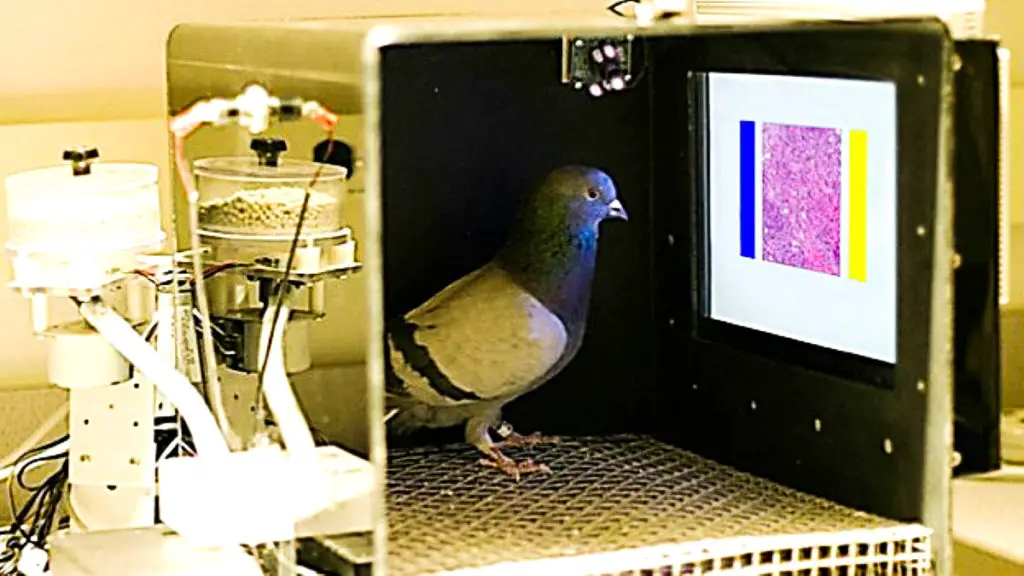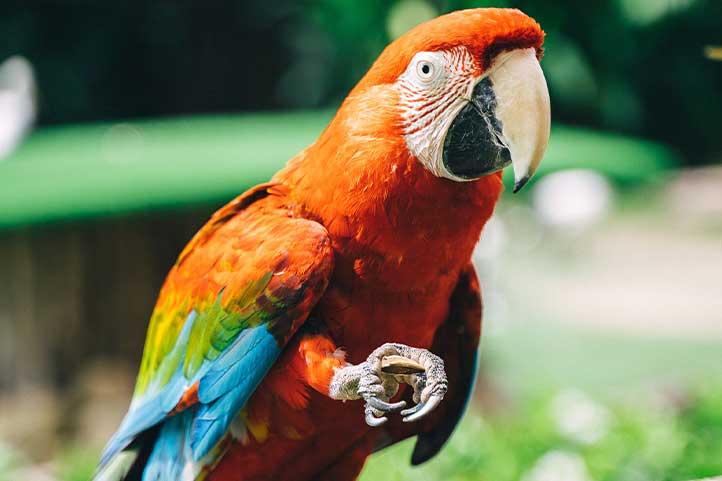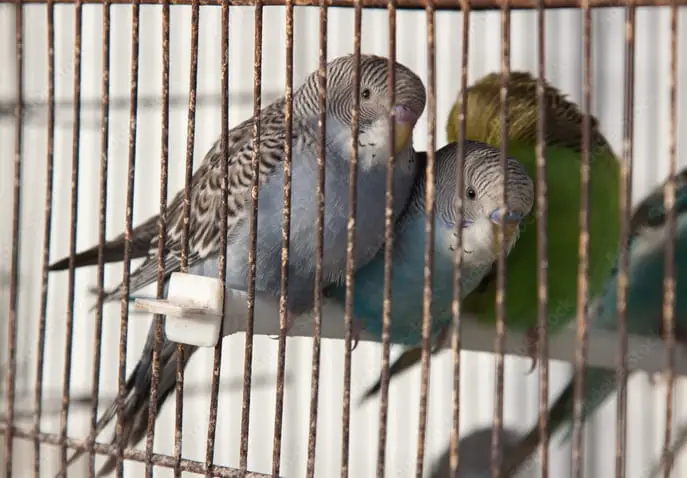Translated by Nick R
Several diseases in birds are treatable and in most cases can be counteracted with good care and of course, vaccination. But what happens when diseases cause serious lesions such as tumors? The answer is given below.
Table of Contents
Can birds develop tumors and cancer?
Yes, birds, and other animals, including us, can develop cancer. It’s well known that cancer has become one of the flagship diseases for modern medicine in our times because of its complexity. Cancer is described as a disease in which the body cells divide (mitosis) endlessly, turning into a tumoral tissue (diseased cells) that invades and affects other healthy tissues.
The cells of such tissue forget their genetic instructions and lose control of themselves. I would like to show you two examples of scenarios. Imagine for a moment that you have a map that tells you the route to get somewhere, but for some reason, the map is missing a part; so, you get lost. Or, on the other hand, imagine a chocolate factory with defective machines; each unit will be poorly produced, some will have no package and some will have no chocolate. The same thing happens with cancer.
What is a tumor?
Cancer manifests itself through different symptoms, but the most evident affectation is the malformations that occur in the tissues, due to the accelerated and uncontrolled division of cells. This division becomes an abnormal mass called neoplasia, whose growth exceeds that of healthy tissue and which functions as an automaton, programmed to reproduce itself without any specific function (if it was muscle, it ceases to be muscle).
Keep in mind that not all tissue malformations are neoplastic and not all neoplastic masses are cancerous, some have another origin and typification, which doesn’t necessarily mean that the undifferentiated tissue induced by a disease becomes a malignant tumor.
Types of tumors in birds
Types of tumors by behavior
Tumors are not always the same and there is a general classification that defines them depending on three main factors: speed, spread and recurrence, which help to classify the tumor as benign or malignant. Here you’ll learn how to distinguish between the two types of tumors according to their behavior.
| Benign | Malignant | |
| Level of differentiation | High | Low |
| Invasive | No | Yes |
| Growth | Slow | Fast |
| Metastasis | No | Yes |
| Relapses | Unlikely | Always |
Benign tumor
In this instance, the tumor tissue is in an initial and milder stage, being considered a non-cancerous tumor. It’s considered non-cancerous because the tumor presents as a well-differentiated mass, and remains localized in the same place with slow growth and without spreading to other tissues. In this case, it is a neoplastic mass that can be removed with a lower probability of relapse.
Malignant tumor
On the other hand, this type of tumor is more aggressive and has far worse consequences on the animal’s health: the less differentiated tissue is invasive neoplastic and grows at an accelerated rate, spreading to other tissues. This process is called metastasis, which means that the localized abnormal tissue begins to invade and affect other tissues that will present larger and larger abnormal masses with less differentiated cells; then, cancer appears.
The bird will relapse several times until it dies.
Classification of tumors by the tissue
Cancer is a disease that affects the way in which cells reproduce, compromising the physiology (functionality) and structure of the tissues that compose the bird’s organs. Birds suffer from different types of cancer, depending on the tissue affected.
Lymphoma
One of the most common neoplasms is composed of damaged lymphocytes that cause malignant tumors, manifesting as lymph nodes (lumps of lymphocytes) frequently in the liver, spleen, and also in other organs that are invaded by metastasis.
Lymphosarcoma
This type of lymphoma is very common in Galliformes (hens), but with its origin in a virus described in Falconiformes, which affects the subcutaneous tissue (under the skin) by infiltration of lymphocytes.
Leukemia
Leukemia is a malignant tumor that affects blood cells, specifically leukocytes, erythrocytes, and platelets; decreasing red blood cells (carry oxygen) and increasing the number of undifferentiated (tumor) white blood cells (immune system).
Sarcoma
A type of tumor present in the mesoderm tissues (origin layer of bones, muscles, blood), very common in pet birds of the Psittaciformes order, such as macaws, cockatoos, parakeets, and other parrots.
Fibrosarcoma
A type of tumor that causes cancer of connective tissue (organ support) that develops from one of the long bones of the leg or wing of the bird. The skin may be ulcerated as the tumor grows, which may spread to other organs by metastasis. Tumors in the tissue may also manifest benignly in fibroids.
Carcinoma
Carcinomas occur in epithelial tissue (skin, glands, mucous membranes), very common in pet birds such as chickens, parakeets, and canaries.
Squamous cell carcinoma
Keratoacanthoma is a malignant tumor of the skin. This type of tumor occurs on the wingtips, legs, toes, around the beak, and eyes, caused by exposure to high levels of sunlight (UV rays).
Adenoma
A keratoacanthoma is a malignant tumor of the skin. This type of tumor occurs on the wingtips, legs, toes, around the beak and eyes, caused by exposure to high levels of sunlight (UV rays).
Adenomas are benign tumors that occur in glandular tissue (glands).
Pituitary adenoma
This is the most common adenoma in pet birds, often affecting cockatiels and budgerigars. The tumor manifests as abnormal masses in the pituitary gland, responsible for regulating hormones (balance of the organism), causing excessive thirst and increased urination (urinating); in addition to muscle spasms and convulsions.
Papilloma
Tumors in the skin and mucous membranes can present themselves as malignant or benign as in the case of papilloma, which manifests itself through warts produced by the papillomavirus. However, the tumor may develop into cancer in more advanced stages.
Osteoma
It is a benign neoplasm that manifests as encapsulated nodules (localized tumors surrounded by a layer of tissue), affecting bones anywhere in the body, but frequently occurs in the bones of the skull and vertebrae.
Hemangioma
A benign tumor of endothelial (blood vessel lining) cells that cause an abnormal accumulation of blood vessels in the skin or internal organs. If the tumor progresses it will develop into its malignant form: hemangiosarcoma.
Lipoma
This is another benign tumor that frequently affects budgerigars, manifesting as lumps in the adipose tissue (fat cells under the skin), especially in the keel of the bird. Surgery is not required unless the tumor grows very large (rarely happens).
Xanthoma
Although they are not neoplasms as such, xanthomas are considered benign tumors that manifest as yellow, fatty masses anywhere on the body, especially on the wingtips, keel and breast of species such as cockatiels and budgerigars. They tend to ulcerate and bleed as they grow.
Prevention and treatment of bird tumors
Causes of the occurrence of tumors
Tumors are basically caused by three factors with different origins:
- Genetic factors.
- Environmental factors.
- Factors of viral origin.
So…
Do tumors have a genetic origin?
Yes, if the bird is predisposed to suffer from a disease that its parent suffered or to inherit a genetic error in its genes. Environmental factors have a close relationship with these errors as well. Continue reading.
Can tumors be caused by environmental factors?
Pollution is a phenomenon that plays a major role in the mutation of genes. In this case, birds, like the rest of the animal kingdom, face changes in the atmosphere and in general, all the effects of man’s actions on the environment.
Which viral diseases cause tumors?
In birds, tumors can be induced by different causes and diseases, among them, diseases of viral origin. Viruses are infectious agents that use the genetic material of their host cell for their reproduction, which can lead to their replication process damaging the genetic instruction manual of the cells they infect.
Alternatively, the bird can acquire the disease in its embryonic stage by transmission and subsequently develop a tumor.
Marek’s disease
It’s a neoplastic viral disease caused by a herpes virus. It’s very contagious and causes paralysis due to the presence of lymphomas (tumor cells) that proliferate by infiltration from the nerves to various organs such as the liver, ovaries, kidneys, lungs, heart, spleen, and skin. In other words, the disease causes malignant tumors that lead to cancer. Be careful because it is one of the diseases with the highest mortality in chickens.
Marek’s disease can have three clinical pictures:
- Nervous: when tumor cells infiltrate the peripheral nervous system, particularly the sciatic nerve.
- Visceral: this clinical picture shows the proliferation of tumors in various organs or viscera, from the liver and spleen to other organs.
- Flaccid neck: when the bird presents a transitory paralysis in the neck, caused by the infection of the most virulent strains of the disease.
Bursitis
Bursitis or bursa of Fabricius disease is caused by the Birnavirus and affects the lymphatic system (immune system) of the bird, producing inflammation and subsequent atrophy of this special organ, responsible for the production of lymphocytes. The malformations caused by bursitis can lead to lymphosarcomas or lymphoid tumors (affecting the lymphatic system).
Lymphoid leukosis
This disease is characterized by the growth of neoplastic masses of lymphoblasts located in the viscera and originating in the bursa of Fabricius, where lymphomas develop and spread to other organs.
Myelocytomatosis
Myelocytomatosis is a disease of viral origin that affects the myelocytes of the bone marrow, causing malignant tumors (myeloma) to appear in various organs of the body, frequently present in bones and cartilage.
Erythroblastosis
It presents intravascular proliferation of immature erythrocytes (blood cells) that cause cancer (leukemia), then the bird begins to suffer from severe anemia (extreme weakness).
Osteopetrosis
The periosteum (membrane covering the bone) shows an obvious thickening with a rocky appearance on the bird’s legs.
Adenocarcinomatosis
It is a malignant tumor that manifests itself through thickened nodules in the digestive tract and reproductive tract.
Leiomyoma
Leiomyoma is a tumor of smooth muscle cells and in poultry in the oviduct ligaments: it usually affects hens, presenting lumps in the reproductive tract.
Cholangioma
A type of liver tumor that develops in the cells of the bile ducts. It can occur as a benign neoplasm, as well as malignant, manifesting as a cholangiocarcinoma.
Learn more at the 21 most common diseases in birds.
How to prevent cancer in your bird?
Prevention is the basis to keep our birds healthy. Now that you know the different ways in which tumors and cancer manifest themselves in birds, surely you must be asking yourself: Can I prevent tumors and cancer in my bird?
The answer is Yes, you can prevent and cure cancer in birds. Next, you’ll learn how to act in a possible situation.
Up-to-date vaccinations
Some of the most common viral diseases in birds have the potential to develop tumors that turn into cancer. Vaccinate your birds with all the required antivirals.
Healthy habits
A healthy diet and basic daily care will help strengthen your winged companions’ health and improve their well-being. In this case I recommend you to consider the care of each species.
Avoid stress
Stress can affect your bird’s health at different levels, causing or inducing physical and mental health problems. Decrease anxiety in your birds by means of exercises allowing them to spend enough time out of the cage. Avoid excessive noise and situations that provoke nervousness.
Attention to symptoms
Before discovering how to prevent and treat cancer, you must first recognize the symptoms that appear in the bird that suffers from it. Check and visit periodically.
Symptoms
- Tiredness for no apparent reason.
- Fever
- Weight loss and lack of appetite.
- Low mood.
- Pain.
- Loss of feathers.
- Lumps or swellings.
- Bleeding.
What should I do if my bird has cancer?
If you have already identified the symptoms and it is evident that your bird has tumors, whether benign or malignant, then the only option is to take it to the veterinarian immediately. In many cases, the bird can be saved by early detection of the symptoms before it develops into a malignant tumor.
Once the veterinarian has detected the disease and their diagnosis indicates that the bird does indeed have a tumor or the tumor has progressed so far that it has turned into cancer, you must begin treatment.
Treatments
Cancer can be treated in any animal species and, of course, birds are no exception. If your bird is in these instances and the tumors have developed enough to generate cancer, your friend has only three options:
Surgery
It’s the most popular and valued option. Surgery represents an alternative that depends on the type of neoplasia: superficial or deep. When the involvement is very deep or the tissue has advanced necrosis, the bird runs the risk that, ultimately, if surgery to repair is not feasible, it will undergo surgery for amputation of the affected area.
Whereas removal of a shallower benign tumor will, in many cases, be the ultimate solution.
Chemotherapy
This treatment is based on drugs, administered orally or intravenously to the bird, that attack the damaged cells that generate the tumors. Chemotherapy has against it, the effect on healthy cells, which are also affected.
Radiotherapy
Radiotherapy is a treatment that acts locally and not on the whole body as it happens with chemotherapy, by means of radiation in the affected area directly, destroying the damaged cells.
Now you know everything about cancer in birds, pay attention to the signs and take good care of your friend. Tumors are silent and very dangerous, turn on the alarm if you notice any of the symptoms Save the bird!


